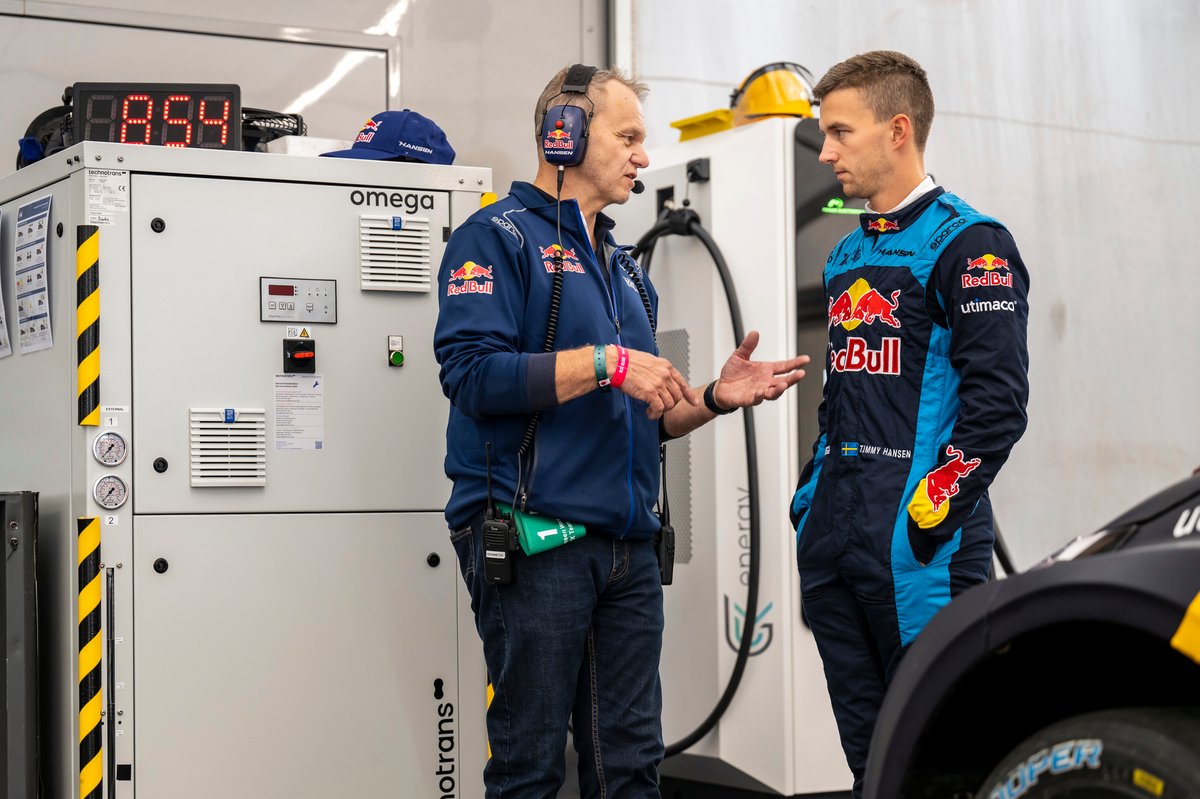
It’s not much by any measure, but 0.011 seconds represented a victory of sorts for electric racing over the traditional internal combustion engine when the World Rallycross Championship visited Norway’s Hell circuit in August. The 38.058s fastest lap set by KMS VW driver Johan Kristoffersson on his way to victory in the first round of World RX’s new electric era just shaded the 38.069s from Andreas Bakkerud’s conventionally propelled EKS Audi in the European RX1 final held on the same day.
That’s no mean feat given the work needed to accommodate the spec, twin-motor Kreisel Electric four-wheel-drive powertrain kit – which packs a 500kW punch. “It was not as simple as just removing the internal combustion engine and putting in the electric powertrain,” points out Hansen World RX Team boss Kenneth Hansen, who runs two Peugeot 208 RX1e cars for sons Timmy and Kevin. That explains why the first round was twice postponed, from Holjes to the Nurburgring – which has been rescheduled – before getting underway in Hell.
There is widespread optimism that the ICE Supercars which now contest the European championship will eventually be comprehensively outclassed in performance stakes, with 2019 world champion Timmy Hansen stating before the season that he was “absolutely convinced that these [electric] cars will be the fastest rallycross cars that we have seen yet”. Specifically when it came to launching off the line, he revealed “we are well ahead on 0-100km/h [62mph] compared to the previous cars”.
But around the lap, it depends on conditions according to his 14-time European champion father.
“We have been quite equal with the combustion cars in the European championship so far, but it’s much more potential in it,” Hansen Sr tells Autosport. “We could be quite faster than we are”.
The stats bear that out. After taking a 1-0 lead in Norway, the new breed of electric machines were outpaced – albeit only by 0.025s – on Saturday at Riga, where Enzo Ide’s best lap of 47.875s in Euro RX1’s Heat 2 pipped Kristoffersson’s 47.900s from the round two final. Rain rendered times from Euro RX1’s final on Sunday incomparable with World RX’s corresponding round three final, before Kristoffersson this time outpaced Ide in last weekend’s most recent round at Montalegre by 0.283s – his 41.232s best comparing to Ide’s 41.515s. So far, it’s 2-1 to the electric cars, but it’s not conclusive yet.

“It depends on where we are, which track and which conditions,” Hansen replies when asked how close to the limit the cars are currently. “Because sometimes we are I believe very close or even on 100%, but sometimes perhaps we are on 85%. It’s difficult to answer exactly but it’s definitely more possibilities and more potential there.”
As Hansen explains, “it’s not only in our hands to learn and to set up the chassis very well and also adapt the mapping correct, the torque split between front and rear, it’s also a journey to get the right software”.
This is ultimately out of the hands of the teams, which are currently in discussion with kit supplier Kreisel and the FIA over what degree of freedom will be permitted. This is an important question for Rallycross Promoter GmbH, as it works out the desired level of sophistication for the cars to reach before engineering nous becomes more important than driving skill.
“It is clear that we are only in the very earliest stages of development of the RX1e cars, with plenty of untapped potential,” Arne Dirks, Rallycross Promoter Executive Director, says. “With World RX being the pinnacle of the sport, we are obviously eager to unlock as much of that potential as we can.
"I’m not negative where we are, I’m very positive that we started like we did. But it has more potential so we look forward to get that out of the cars" Kenneth Hansen
“But at the same time, we need to remain mindful that this is a championship for both manufacturers and independent entrants. We cannot afford to let costs spiral out of control, as the priority has to be to maintain a level playing field. So while we obviously encourage development and innovation, there will be certain restrictions in place to avoid any kind of ‘arms race’ and ensure World RX remains a fair and equitable sport with the same opportunities for all.”
Hansen, who has been “positively surprised” by the spectacle of the electric cars – “you don’t really notice about the sound so much, it’s more the battles and the fights and so on” – can see both sides of the argument. But he’s hopeful that teams “can test a little more on the software side”.
“From the FIA side, the basic is that the cars should be driven by the drivers,” he adds, “and not too much help to gain performance should be there. That’s a basic from FIA not to get it too much traction control, too much left to the computer to do it. And that’s a balance to find the right way.

“At the moment it’s quite up to the driver, but it’s very difficult for them to control it. You can see sometimes we have rear wheelspin, and sometimes we have front wheelspin.”
But he recognises too that allowing too much freedom will merely cause the best-funded teams with the most people to dominate. Currently, teams are limited in the number of trackside staff they are permitted on events, with 25 passes issued per competitor – rising to 46 for two-car teams – which includes the driver, team principal, team manager, and guest passes. Of these, six engineering personnel are permitted per car on single and two-car teams, but more sophisticated software would invariably require more specialists to control it.
“Of course, it’s not possible for the FIA to limit what people we have behind the scenes to work during the races,” Hansen points out.
The danger, as Dirks acknowledges, is of a “complete engineering sport” that Hansen knows wouldn’t create any added value for spectators.
“That’s not what we’re aiming for,” he says. “The teams are quite united but also FIA understand the problem and also Kreisel and the promoter understand it, and together we will work something out that will be better.
“I’m not negative where we are, I’m very positive that we started like we did. But it has more potential so we look forward to get that out of the cars. If we get it a little more, for sure this is the fastest cars that ever will be at the moment on a rallycross track.”
Hansen, though, acknowledges that it’s still early days: “First of all, we need to learn a little bit more and see what issues can come up and what are we learning and then after to go ahead. In total we are agreed that we need to do some more steps forward and not rush too fast into it. We need to balance it well and not rush into something that goes wrong. What we’ve started with is very good.”
He also knows that there are more important issues to tackle for the time being, such as getting more cars on the grid. Much anticipation surrounds the GCK Motorsport Lancia Delta programme that is expected later this year, but there is still some way to go before grid sizes are comparable with those on offer in the combustion-driven European series. While there were just 13 entrants in Latvia and Portugal, the grid reached a peak of 25 entrants in Sweden, while 20 drivers started in Hungary, and 18 in Norway – averaging at 15.4 cars per round.

“We compare with the old days when we were 20, 25 on the grid, we are still only eight,” he says. “More is coming and joining quite soon so I think that’s the major point, to get more cars on the grid, to have better battles, and then I’m quite sure that this will be good.
“The main thing now is to build the sport back and get the value in the sport as high as possible, get the manufacturers interested. I don’t say we should have the manufacturers back with manufacturer teams, but at least get more support for the teams from manufacturers because to be a world championship in motorsport, it’s still very low budgets compared with other disciplines.
“We want to get the sport back on where it belongs, get more cars, more drivers in and then to continue what we do now very good.”
Even if grid sizes are small, these are encouraging times for rallycross. The lap times are a clear sign of progress but, as Hansen knows well given the exodus of manufacturers at the end of 2018, the balance of complexity and driver skill needs to be right for the world championship – and RX as a whole – to thrive.








